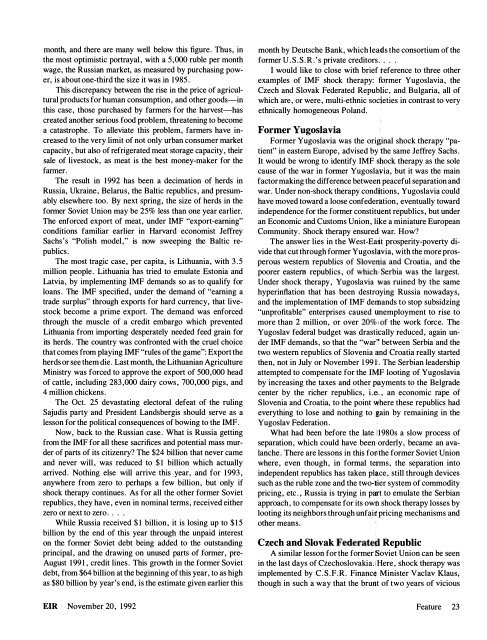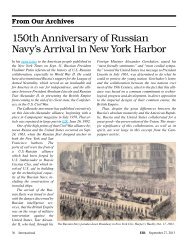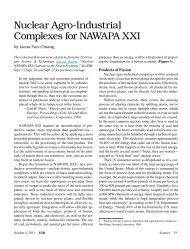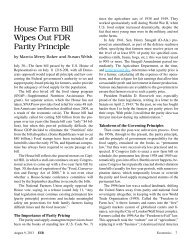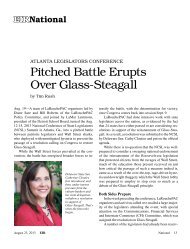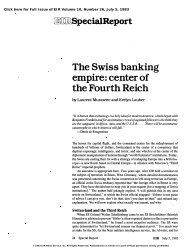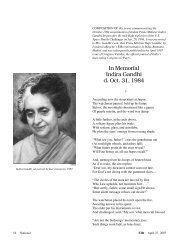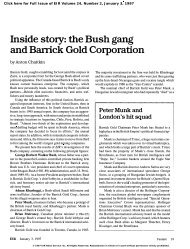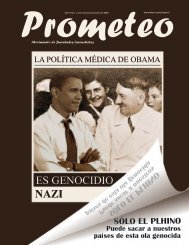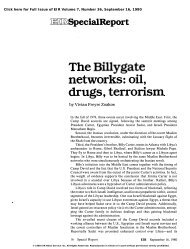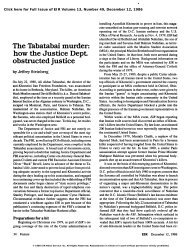Executive Intelligence Review, Volume 19, Number 46, November ...
Executive Intelligence Review, Volume 19, Number 46, November ...
Executive Intelligence Review, Volume 19, Number 46, November ...
Create successful ePaper yourself
Turn your PDF publications into a flip-book with our unique Google optimized e-Paper software.
month, and there are many well below this figure. Thus, in<br />
the most optimistic portrayal , with a 5,000 ruble per month<br />
wage, the Russian market, as measured by purchasing power,<br />
is about one-third the size it was in <strong>19</strong>85.<br />
This discrepancy between the rise in the price of agricultural<br />
products for human consumption, and other goods-in<br />
this case, those purchased by farmers for the harvest-has<br />
created another serious food problem, threatening to become<br />
a catastrophe. To alleviate this problem, farmers have increased<br />
to the very limit of not only urban consumer market<br />
capacity, but also of refrigerated meat storage capacity, their<br />
sale of livestock, as meat is the best money-maker for the<br />
farmer.<br />
The result in <strong>19</strong>92 has been a decimation of herds in<br />
Russia, Ukraine, Belarus, the Baltic republics, and presumably<br />
elsewhere too. By next spring, the size of herds in the<br />
former Soviet Union may be 25% less than one year earlier.<br />
The enforced export of meat, under IMF "export-earning"<br />
conditions familiar earlier in Harvard economist Jeffrey<br />
Sachs's "Polish model," is now sweeping the Baltic republics.<br />
The most tragic case, per capita, is Lithuania, with 3 .5<br />
million people. Lithuania has tried to emulate Estonia and<br />
Latvia, by implementing IMF demands so as to qualify for<br />
loans. The IMF specified, under the demand of "earning a<br />
trade surplus" through exports for hard currency, that livestock<br />
become a prime export. The demand was enforced<br />
through the muscle of a credit embargo which prevented<br />
Lithuania from importing desperately needed feed grain for<br />
its herds . The country was confronted with the cruel choice<br />
that comes from playing IMF "rules of the game": Export the<br />
herds or see them die. Last month, the Lithuanian Agriculture<br />
Ministry was forced to approve the export of 500,000 head<br />
of cattle, including 283,000 dairy cows, 700,000 pigs, and<br />
4 million chickens.<br />
The Oct. 25 devastating electoral defeat of the ruling<br />
Sajudis party and President Landsbergis should serve as a<br />
lesson for the political consequences of bowing to the IMF.<br />
Now, back to the Russian case. What is Russia getting<br />
from the IMF for all these sacrifices and potential mass murder<br />
of parts of its citizenry? The $24 billion that never came<br />
and never will, was reduced to $1 billion which actually<br />
arrived. Nothing else will arrive this year, and for <strong>19</strong>93,<br />
anywhere from zero to perhaps a few billion, but only if<br />
shock therapy continues. As for all the other former Soviet<br />
republics, they have, even in nominal terms, received either<br />
zero or next to zero . . . .<br />
While Russia received $1 billion, it is losing up to $15<br />
billion by the end of this year through the unpaid interest<br />
on the former Soviet debt being added to the outstanding<br />
principal, and the drawing on unused parts of former, pre<br />
August <strong>19</strong>91, credit lines. This growth in the former Soviet<br />
debt, from $64 billion at the beginning of this year, to as high<br />
as $80 billion by year's end, is the estimate given earlier this<br />
EIR <strong>November</strong> 20, <strong>19</strong>92<br />
month by Deutsche Bank, which leads the consortium of the<br />
former U .S.S.R.'s private creditors.' . . .<br />
I would like to close with brief teference to three other<br />
examples of IMF shock therapy: former Yugoslavia, the<br />
Czech and Slovak Federated Republic, and Bulgaria, all of<br />
which are , or were, multi-ethnic sodeties in contrast to very<br />
ethnically homogeneous Poland.<br />
Former Yugoslavia<br />
Former Yugoslavia was the original shock therapy "patient"<br />
in eastern Europe, advised by the same Jeffrey Sachs.<br />
It would be wrong to identify IMF shock therapy as the sole<br />
cause of the war in former YugoslaVia, but it was the main<br />
factor making the difference between peaceful separation and<br />
war. Under non-shock therapy conditions, Yugoslavia could<br />
have moved toward a loose confederation, eventually toward<br />
independence for the former constituent republics, but under<br />
an Economic and Customs Union, like a miniature European<br />
Community. Shock therapy ensured war. How?<br />
The answer lies in the West-Ea$t prosperity-poverty divide<br />
that cut through former Yugoslavia, with the more prosperous<br />
western republics of Slovenia and Croatia, and the<br />
poorer eastern republics, of which, Serbia was the largest.<br />
Under shock therapy, Yugoslavia was ruined by the same<br />
hyperinflation that has been destroying Russia nowadays,<br />
and the implementation of IMF demands to stop subsidzing<br />
"unprofitable" enterprises caused unemployment to rise to<br />
more than 2 million, or over 20% iof the work force. The<br />
Yugoslav federal budget was drastically reduced, again under<br />
IMF demands, so that the "war'� between Serbia and the<br />
two western republics of Slovenia and Croatia really started<br />
then, not in July or <strong>November</strong> <strong>19</strong>91:. The Serbian leadership<br />
attempted to compensate for the IMF looting of Yugoslavia<br />
by increasing the taxes and other payments to the Belgrade<br />
center by the richer republics, i.e., an economic rape of<br />
Slovenia and Croatia, to the point where these republics had<br />
everything to lose and nothing to gain by remaining in the<br />
Yugoslav Federation.<br />
What had been before the late i<strong>19</strong>80s a slow process of<br />
separation, which could have been'orderly, became an avalanche.<br />
There are lessons in this fOri the former Soviet Union<br />
where, even though, in formal terms, the separation into<br />
independent republics has taken place, still through devices<br />
such as the ruble zone and the two-tier system of commodity<br />
pricing, etc., Russia is trying in part to emulate the Serbian<br />
approach, to compensate for its owh shock therapy losses by<br />
looting its neighbors through unfair pricing mechanisms and<br />
other means.<br />
Czech and Slovak Federated Republic<br />
A similar lesson for the former Soviet Union can be seen<br />
in the last days of Czechoslovakia. i Here, shock therapy was<br />
implemented by C.S.F.R. Finance Minister Vaclav Klaus,<br />
though in such a way that the brunt of two years of vicious<br />
Feature 23


